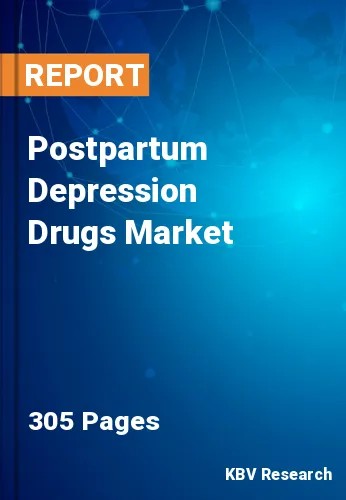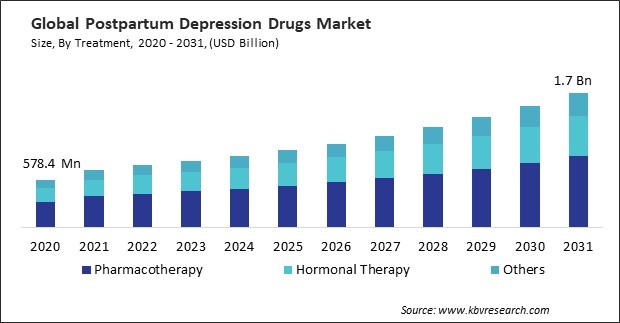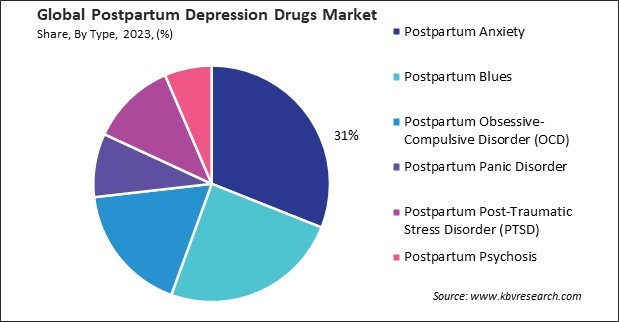
“Global Postpartum Depression Drugs Market to reach a market value of USD 1.7 Billion by 2031 growing at a CAGR of 9.4%”
The Global Postpartum Depression Drugs Market size is expected to reach $1.7 billion by 2031, rising at a market growth of 9.4% CAGR during the forecast period.
There is growing awareness among healthcare professionals and the public in the Asia-Pacific region regarding postpartum depression (PPD) and its impact on maternal mental health. Improved recognition of PPD symptoms leads to more women seeking diagnosis and treatment, thereby driving up demand for pharmacotherapy. Consequently, the Asia pacific region would acquire nearly 28% of the total market share by 2031.

Neuroendocrinology explores the interactions between the nervous system and endocrine system, which is crucial during the postpartum period. A deeper understanding of neuroendocrine changes allows for earlier identification of potential problems. Thus, rising focus on neuroendocrinology is driving the growth of the market.
Additionally, Awareness campaigns educate healthcare providers and new mothers about the symptoms and risks of postpartum depression (PPD). Furthermore, awareness initiatives often include training healthcare professionals to recognize signs of PPD during routine postnatal care visits. Thus, increasing awareness and screening programs are driving the market’s growth.
However, Many PPD drugs, particularly antidepressants, can cause side effects such as nausea, fatigue, dizziness, insomnia, and weight gain. In addition, for newer PPD drugs, there may be limited long-term safety data available. This uncertainty can make healthcare providers and patients cautious about using these medications until more comprehensive data is available. Hence, side effects and safety concerns of the drug are hindering the growth of the market.
Moreover, Clinical trials for new these drugs were halted or delayed due to pandemic-related restrictions. This slowed the development and approval process of innovative therapies that could have benefited patients. Economic uncertainties during the pandemic affected patients’ ability to afford medications and healthcare services. This financial strain further limited access to these drugs, especially in regions with inadequate healthcare coverage. The isolation and stress caused by the pandemic exacerbated mental health conditions, including postpartum depression. This increased demand for treatment but posed challenges in delivering effective care and support remotely. Thus, the COVID-19 pandemic had a negative impact on the market.
The market is categorized by distribution channel into hospital pharmacies, retail pharmacy, and others. The retail pharmacy segment witnessed 35% revenue share in the market in 2023. Pharmacists in retail settings are increasingly trained to identify symptoms of PPD and collaborate with healthcare providers to facilitate appropriate medication management.
Based on type, the market is divided into postpartum blues, postpartum anxiety, postpartum obsessive-compulsive disorder (OCD), postpartum post-traumatic stress disorder (PTSD), postpartum panic disorder, and postpartum psychosis. The postpartum blues segment attained 25% revenue share in the market in 2023. Postpartum blues, also known as baby blues, are common and transient mood changes experienced by many new mothers within the first few weeks after childbirth.

On the basis of treatment, the market is segmented into pharmacotherapy, hormonal therapy, and others. In 2023, the hormonal therapy segment attained 29% revenue share in the market. After childbirth, women experience significant hormonal fluctuations, including drops in estrogen and progesterone levels.
By route of administration, the market is divided into parenteral, oral, and others. The parenteral segment procured 24% revenue share in the market in 2023. Parenteral medications typically have a faster onset of action compared to oral medications. This rapid response is beneficial for women experiencing severe or acute symptoms of postpartum depression (PPD), providing quicker relief and stabilization of mood.
Free Valuable Insights: Global Postpartum Depression Drugs Market size to reach USD 1.7 Billion by 2031
Region-wise, the market is analyzed across North America, Europe, Asia Pacific, and LAMEA. The North America region witnessed 39% revenue share in the market in 2023. Access to healthcare services, including mental health professionals and pharmacotherapy, is generally better in North America than in many other regions. This accessibility facilitates timely diagnosis and treatment initiation for women experiencing PPD symptoms. The pharmaceutical industry in North America is well-developed, with a wide range of medications approved for treating PPD.
| Report Attribute | Details |
|---|---|
| Market size value in 2023 | USD 820 Million |
| Market size forecast in 2031 | USD 1.7 Billion |
| Base Year | 2023 |
| Historical Period | 2020 to 2022 |
| Forecast Period | 2024 to 2031 |
| Revenue Growth Rate | CAGR of 9.4% from 2024 to 2031 |
| Number of Pages | 305 |
| Number of Tables | 470 |
| Report coverage | Market Trends, Revenue Estimation and Forecast, Segmentation Analysis, Regional and Country Breakdown, Porter’s 5 Forces Analysis, Company Profiling, Companies Strategic Developments, SWOT Analysis, Winning Imperatives |
| Segments covered | Treatment, Route of Administration, Distribution Channel, Type, Region |
| Country scope |
|
| Companies Included | Pfizer, Inc., Eli Lilly And Company, Novartis AG, GlaxoSmithKline PLC (GSK), Merck & Co., Inc., Biogen, Inc., Teva Pharmaceutical Industries Ltd., Bausch Health Companies, Inc.(DermTech, Inc.), Cipla Limited and Sage Therapeutics, Inc. |
By Treatment
By Route of Administration
By Distribution Channel
By Type
By Geography
This Market size is expected to reach $1.7 billion by 2031.
Rising focus on neuroendocrinology are driving the Market in coming years, however, Side effects and safety concerns of the drug restraints the growth of the Market.
Pfizer, Inc., Eli Lilly And Company, Novartis AG, GlaxoSmithKline PLC (GSK), Merck & Co., Inc., Biogen, Inc., Teva Pharmaceutical Industries Ltd., Bausch Health Companies, Inc.(DermTech, Inc.), Cipla Limited and Sage Therapeutics, Inc.
The expected CAGR of this Market is 9.4% from 2024 to 2031.
The Pharmacotherapy segment generated the Market by Treatment in 2023; thereby, achieving a market value of $875.4 million by 2031.
The North America region dominated the Market by Region in 2023, and would continue to be a dominant market till 2031; thereby, achieving a market value of $622.2 million by 2031.
Our team of dedicated experts can provide you with attractive expansion opportunities for your business.
 Drivers
Drivers
 Restraints
Restraints
 Opportunities
Opportunities
 Challenges
Challenges
